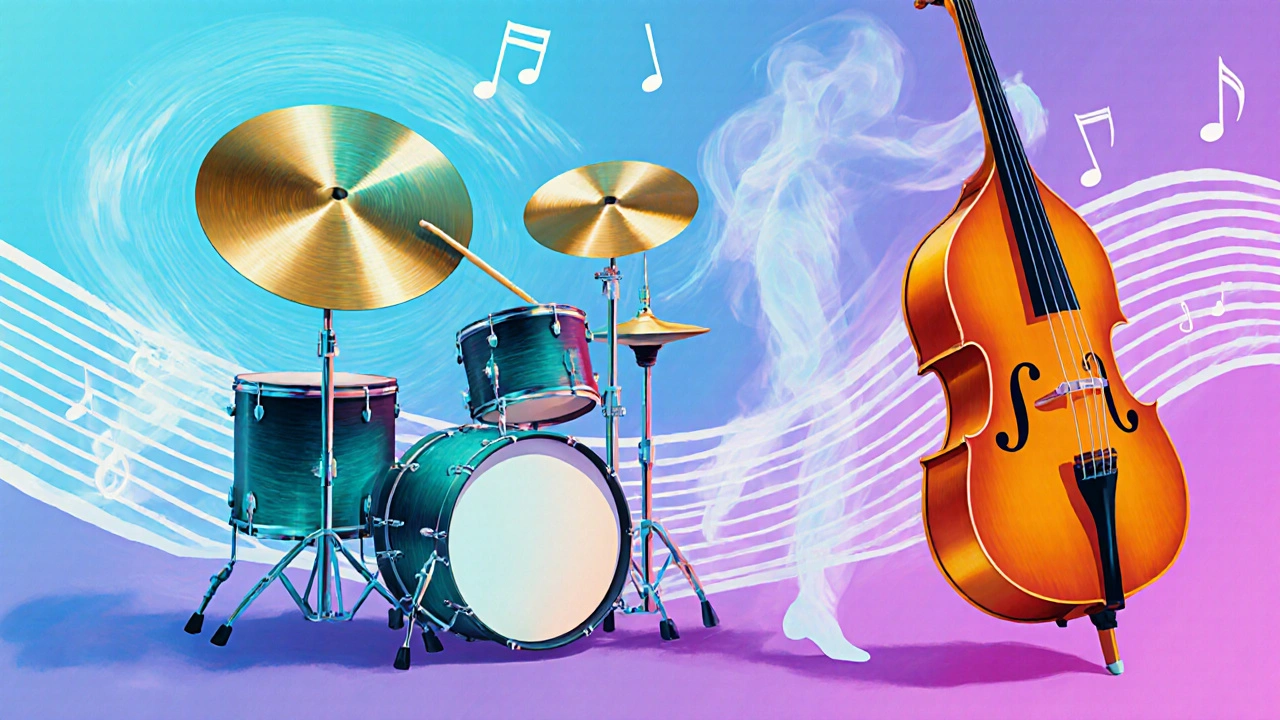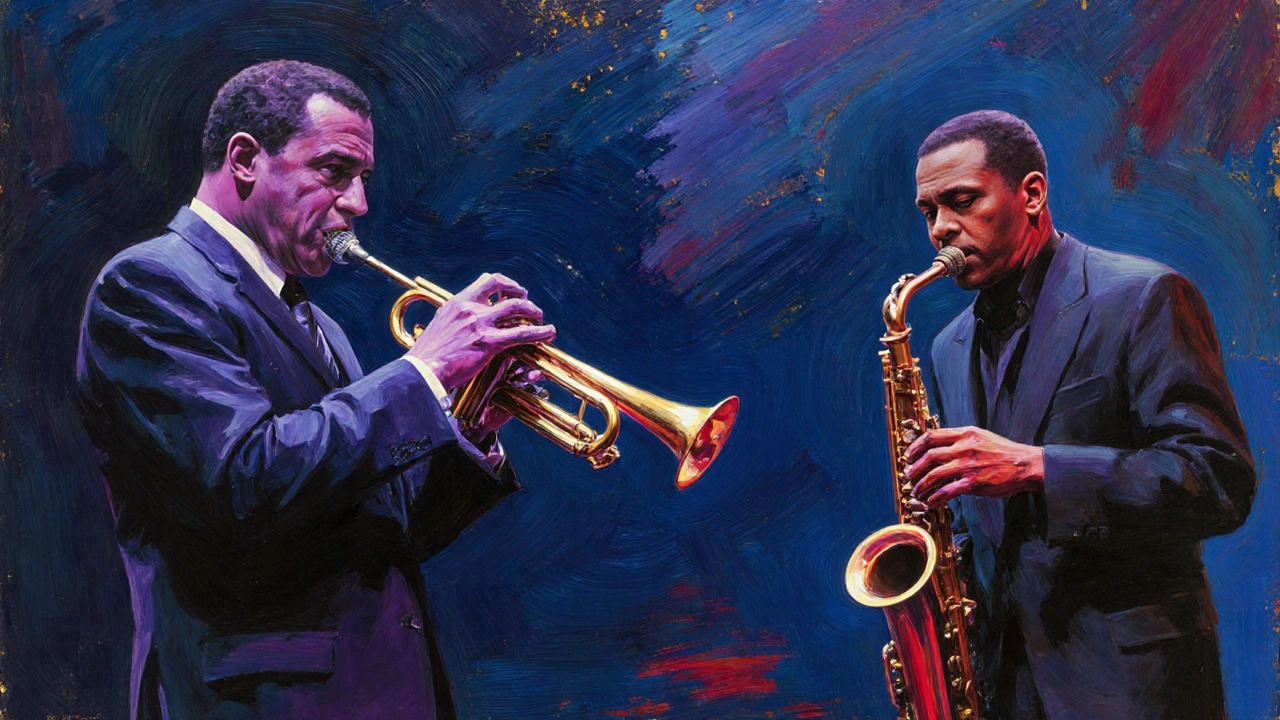Jazz Chord Progression Generator
Generate authentic jazz chord progressions based on classic standards. Select a song, key, and style to see the chord changes and recommended scales for improvisation.
Chord Progression
Recommended Scales
When you hear a saxophone wail or a piano tumble into a bright chord, you’re instantly transported into the world of Jazz music. It isn’t just a genre; it’s a living conversation where notes, rhythms, and spontaneous ideas collide. This guide breaks down what makes jazz click, from the swing feel that gets your foot tapping to the improvisational tricks that turn a simple melody into a personal statement.
What gives jazz its distinct character?
At its core, jazz is built on three pillars: a set of tonal colors, a flexible rhythmic feel, and a culture of improvisation. Unlike many pop forms that stick to a strict chord‑melody structure, jazz lets each player reinterpret the harmony in real time. The result is a music that feels both familiar and fresh every time you listen.
Below is the first formal definition of the genre, marked for knowledge‑graph usage:
Jazz music is a musical style that originated in the early 20th‑century African‑American communities of New Orleans, characterized by syncopated rhythms, blue notes, and collective improvisation.
Core musical building blocks
- Blue notes: Slightly lowered third, fifth, or seventh degrees that give a ‘bent’ emotional quality.
- Extended chords: Seventh, ninth, thirteenth chords that add richness and tension.
- Jazz standards: Repertoire pieces like "Autumn Leaves" or "All The Things You Are" that serve as common ground for jam sessions.
When you first explore a standard, you’ll likely encounter a Jazz standard a widely known composition that provides a harmonic framework for improvisation. Learning a handful of these tunes instantly gives you a language to speak the jazz dialect.
Swing and syncopation: The rhythmic heart
One of the most recognizable traits of jazz is the swing feel. Instead of playing straight eighth notes, musicians place the first note slightly longer than half a beat and the second shorter, creating a lilting "long‑short" pattern.
Technically, swing is a type of Swing rhythm a rhythmic pattern where the beat is divided into a triplet feel, with emphasis on the first and third subdivisions. Drummers often accent the ride cymbal on beats two and four, while the bass walks through the chord changes, keeping the momentum alive.
Syncopation, the deliberate placement of accents on weak beats, adds surprise. A classic example is the “off‑beat” piano comp that punctuates the groove, making listeners lean in to hear what comes next.

The language of improvisation
Improvisation is jazz’s soul‑searching conversation. A soloist takes a melody and re‑imagines it on the spot, weaving in scales, motifs, and rhythmic twists.
Here’s the formal definition for reference:
Improvisation the real‑time creation of melodic, harmonic, or rhythmic material during a performance, often based on a pre‑existing chord progression or theme
To improvise effectively, musicians use three main tools:
- Scale knowledge: Major, minor, Dorian, Mixolydian, and the blues scale are the go‑to palettes.
- Motivic development: Taking a short rhythmic or melodic idea and repeating it with variations.
- Rhythmic displacement: Shifting a phrase ahead or behind the beat to create tension.
Mastering these tricks takes practice, but even a simple motif played with confidence can turn a bland solo into a storytelling moment.
Major jazz styles at a glance
Jazz hasn’t stayed static; each decade birthed a new style that reflected cultural shifts. The table below compares five key styles, highlighting their typical tempo, harmonic approach, and signature instruments.
| Style | Era | Typical Tempo (BPM) | Harmonic Traits | Key Instruments |
|---|---|---|---|---|
| New Orleans / Dixieland | 1910‑30 | 120‑180 | Collective improvisation, simple chords | Trumpet, clarinet, trombone, tuba |
| Swing | 1930‑45 | 120‑200 | Extended chords, strong rhythm section | Sax, trumpet, piano, upright bass |
| Bebop | 1940‑60 | 200‑300 | Complex chord changes, fast tempos | Alto sax, trumpet, piano, drums |
| Cool Jazz | 1950‑70 | 80‑140 | Relaxed tempos, modal harmony | Baritone sax, French horn, piano |
| Jazz Fusion | 1970‑present | 90‑180 | Electric instruments, rock rhythms | Electric guitar, synth, drums |

Legendary improvisers who shaped the language
Understanding how the masters think can fast‑track your own voice. Below are brief snapshots of two giants, each marked for knowledge‑graph reference.
Miles Davis a pioneering trumpeter whose career spanned bebop, cool jazz, modal jazz, and fusion, known for his minimalist phrasing and relentless innovation often used space rather than notes, letting silence become part of the solo.
John Coltrane a tenor saxophonist famous for his ‘sheets of sound’ approach, deep harmonic exploration, and spiritual compositions like ‘A Love Supreme’ pushed improvisation into long, cascading lines that explored every stone of a chord.
Other innovators such as Thelonious Monk piano composer known for dissonant voicings and angular melodies that challenged conventional harmony demonstrate that ‘breaking the rules’ can become a new set of rules.
Practical steps to start improvising today
- Pick a simple standard (e.g., “Autumn Leaves”). Write down its chord changes and listen to at least three recorded versions.
- Learn the major scale and the corresponding minor scale for each chord. Practice playing the scale in four different rhythmic patterns.
- Create a short three‑note motif. Loop it over the progression, then move the motif up or down a half‑step each time.
- Record yourself. Listen for moments where the phrase lands on the beat versus just after it; adjust to give more swing.
- Join a local jam session or an online video lobby. The only way to internalize improvisation is to trade ideas with other musicians.
Remember, the goal isn’t perfect technical execution but authentic expression. Even a lone hum of a melody, twisted with a blue note, counts as improvisation.
Frequently Asked Questions
Do I need to learn music theory before I can improvise?
No, but a basic grasp of scales and chord symbols speeds up the learning curve. Many great improvisers started by mimicking recordings and picking up patterns by ear.
What’s the difference between swing and straight‑eighth feel?
Swing divides each beat into a triplet, lengthening the first eighth and shortening the second, while straight‑eighth plays them evenly. Swing feels more relaxed and ‘groovy’.
Can I improvise on any instrument?
Yes. While piano and saxophone are common for practice, any melodic or harmonic instrument can partake. The key is understanding the chord changes and developing a personal vocabulary.
How do I develop my own voice instead of copying others?
Start by transcribing solos you love, then alter the phrases-change rhythm, invert intervals, or apply different scales. Over time you’ll notice patterns that feel natural to you.
Is jazz still relevant in 2025?
Absolutely. New artists blend jazz with hip‑hop, electronic, and world music, keeping the improvisational spirit alive. Streaming platforms now host vibrant jazz communities worldwide.

